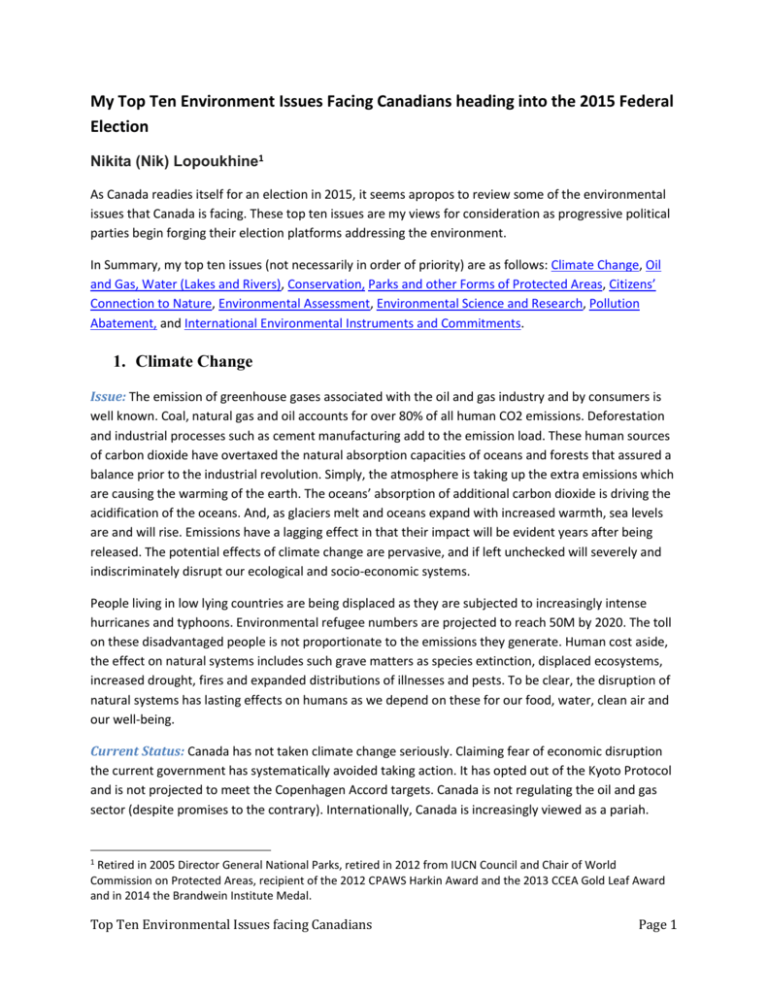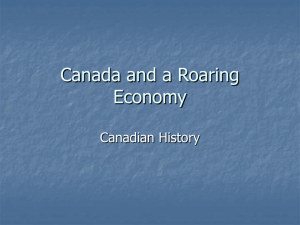Read the full article (PDF) - The Pearson Centre for Progressive Policy
advertisement

My Top Ten Environment Issues Facing Canadians heading into the 2015 Federal Election Nikita (Nik) Lopoukhine1 As Canada readies itself for an election in 2015, it seems apropos to review some of the environmental issues that Canada is facing. These top ten issues are my views for consideration as progressive political parties begin forging their election platforms addressing the environment. In Summary, my top ten issues (not necessarily in order of priority) are as follows: Climate Change, Oil and Gas, Water (Lakes and Rivers), Conservation, Parks and other Forms of Protected Areas, Citizens’ Connection to Nature, Environmental Assessment, Environmental Science and Research, Pollution Abatement, and International Environmental Instruments and Commitments. 1. Climate Change Issue: The emission of greenhouse gases associated with the oil and gas industry and by consumers is well known. Coal, natural gas and oil accounts for over 80% of all human CO2 emissions. Deforestation and industrial processes such as cement manufacturing add to the emission load. These human sources of carbon dioxide have overtaxed the natural absorption capacities of oceans and forests that assured a balance prior to the industrial revolution. Simply, the atmosphere is taking up the extra emissions which are causing the warming of the earth. The oceans’ absorption of additional carbon dioxide is driving the acidification of the oceans. And, as glaciers melt and oceans expand with increased warmth, sea levels are and will rise. Emissions have a lagging effect in that their impact will be evident years after being released. The potential effects of climate change are pervasive, and if left unchecked will severely and indiscriminately disrupt our ecological and socio-economic systems. People living in low lying countries are being displaced as they are subjected to increasingly intense hurricanes and typhoons. Environmental refugee numbers are projected to reach 50M by 2020. The toll on these disadvantaged people is not proportionate to the emissions they generate. Human cost aside, the effect on natural systems includes such grave matters as species extinction, displaced ecosystems, increased drought, fires and expanded distributions of illnesses and pests. To be clear, the disruption of natural systems has lasting effects on humans as we depend on these for our food, water, clean air and our well-being. Current Status: Canada has not taken climate change seriously. Claiming fear of economic disruption the current government has systematically avoided taking action. It has opted out of the Kyoto Protocol and is not projected to meet the Copenhagen Accord targets. Canada is not regulating the oil and gas sector (despite promises to the contrary). Internationally, Canada is increasingly viewed as a pariah. 1 Retired in 2005 Director General National Parks, retired in 2012 from IUCN Council and Chair of World Commission on Protected Areas, recipient of the 2012 CPAWS Harkin Award and the 2013 CCEA Gold Leaf Award and in 2014 the Brandwein Institute Medal. Top Ten Environmental Issues facing Canadians Page 1 Response: In contrast to some forward thinking municipalities, federal mitigation and adaptation strategies have not been drawn up or actioned. Such would be an important step in making clear to Canadians the importance of this issue to present and future generations of Canadians. Mitigation focuses on ways to reduce or eliminate carbon dioxide emissions. Examples include setting aside large tracts of protected landscapes, retrofitting technology and housing to reduce emissions, investing in green energy production and recycling, investing in urban infrastructure such as public transit, and most importantly changing consumer practices through incentives. Adaptation strategies on the other hand anticipate climate change effects and suggest how best to minimise these. Flooding brought on by unusual precipitation patterns occurred recently in Calgary, Manitoba, Halifax, and Toronto. These extreme weather events can be expected to reoccur there and elsewhere. Strategies through infrastructure investment addressing flood defences are critical. Beyond the short term, agriculture needs to focus on developing drought-tolerant crops and species less vulnerable to storms and fires. And, most importantly, there is a need to set aside corridors for the movement of species. 2. Oil and Gas Issue: Canadian oil and gas reserves are estimated to be the third largest in the world. Alberta and Saskatchewan produce approximately 90% of Canadian production. Oil producing provinces benefit from royalties. The federal government derives income from corporate, sales and income taxes linked to this industry. Transportation to markets is a preoccupation for the jurisdictions with landlocked deposits. Given that Canada’s traditional customer, the USA, is decreasing its dependence on Canadian petroleum resources, burgeoning offshore markets are increasingly being targeted along with a general interest to expand the amount of oil and gas shipped to markets. The recent collapse of the value of oil has reduced the urgency in the short term Accordingly, expansion of the network of pipelines (Keystone, East West, Trans Mountain, Gateway, Line 9 Reversal, Churchill, etc.) is under various stages of planning and or review. In the interim, rail transport is increasingly being used. Tankers are used for overseas markets. However, when The National Energy Board Act was weakened through the Omnibus budget bill of 2012 the approval process for the movement of oil and gas products has become undemocratic and suspect at best. Current Status: Environmental impacts associated with the production, transport and use of oil and gas include leaks and spills (including blowouts off shore), localised air pollution, use and contamination of water (particularly linked to fracking), and most importantly emitted greenhouse gases associated with all three phases: production, transportation and use. The USA estimates that over the last 20 years, pipeline incidents have caused over $6.3 billion in property damages. Response: Promised regulations for this industry have been put off by the current Canadian government despite numerous public announcements over the past decade. Such regulations need to address all three phases: production, transportation and use. Top Ten Environmental Issues facing Canadians Page 2 3. Water, (Rivers and Lakes) Issue: Canada is blessed with wide expanses of fresh water, amounting to 1/5th of the global fresh water. This is in contrast to the fact that less than 1% of the world's water is readily available for direct human uses. Across the globe, both animal and plant freshwater species have declined 76 per cent over the past three decades—more than anywhere else on land or at sea. Climate change is acerbating the challenge as drought and extreme weather events alter water distribution and hence availability. Water uses include agriculture and industry; domestic purposes; and energy generation and transport. Increasing competition for water among such users is degrading the very natural resources on which we all depend. Current situation: These facts did not seem to sway Canada’s current government as it replaced the constitutional based protection offered by the Navigable Waters Protection Act (NWPA) (Dating back to 1882) Using an omnibus bill in 2012 a new Act (BillC-45) was introduced that provides federal protection only for Canada's busiest rivers, lakes and oceans (three oceans, 97 lakes and 62 rivers). Without any parliamentary debate, the new Act was passed into law. There was no opportunity to address the fact that the new Act differs from its antecedent role as a tool for environmental protection. The Supreme Court had expressed itself on the matter by recognizing that the NWPA had expansive environmental dimensions beyond the issues of physical barriers. In effect, any waterway not on the list (some 2.5M lakes and rivers) could now be affected by some form of diversion, blockage or construction. It is no longer protected by federal law. The once federal responsibility is now in the hands of provinces, municipalities or individuals. The omnibus bill also neutered the provisions for fishery and habitat protection and this has, in effect, left the water based resources open to unprecedented denigration. The lack of protective legislation has implications for recreational fishing and angling, and other outdoors-related businesses such as outfitters, outdoor clothing and gear retailers, restaurants and hotels. Protecting navigable waterways also protects water supplies, fish and fisheries, and natural water purification and filtration services. Besides providing obvious health benefits to Canadians, securing sources of clean fresh water help communities economically by reducing their infrastructure needs. Withdrawing the federal role of protection is an affront to rural communities. Ironically, these were the communities that were used to justify scrapping the gun registry. Response: The Federal Government has responsibility under the Constitution for fishery, navigation and migratory species. It needs to reinstate its authorities for these by revisiting the recently passed legislation that has transfers the responsibility to other levels of government or individuals who now must depend on common law, or in effect can only deal with their concerns after harm has been done. 4. Conservation Issue: To give conservation a global context some sobering statistics from the 2014 Living Planet Report tells us that the Earth has lost half of its vertebrate species since 1970. There has been an 83 percent decline of species in tropical regions of Latin America. The most affected group of species are those found in freshwater as they have been reduced in number by 76 percent over the last 40 years. In Top Ten Environmental Issues facing Canadians Page 3 Canada, the declining state of the woodland caribou is indicative of Canadian neglect of conservation. The latest assessment by the Canadian Parks and Wilderness Society (CPAWS) posits a 50% decline in the number of woodland caribou (depicted on the Canadian quarter) between 2005 and 2013. Current Status: The current Canadian government announced in 2013 the launch of a national conservation plan. This plan consists of the announcement of funding two ENGOs for acquisition of lands and restoration of wetlands with some additional funding to federal agencies to pursue their conservation mandate, and some funding to connect Canadians to nature (more below). In the meantime, while the 2002 Species at Risk Act (SARA) has not been altered by the current Canadian government, it is not being implemented. Annually, species are assessed by the mandated science committee under SARA to advise the Minister on a recommended risk status who then through the Cabinet lists them under the Act. Despite being listed some two years ago as a threatened species, only six of 51 woodland caribou recovery plans have been drawn up. Further, 67 species put forward by the advisory committee in 2011 have yet to be considered by Cabinet. Without being listed they are not legally protected and their critical habitat has not been identified nor secured. Internationally, when species are listed by the Convention on International Trade in Endangered Species (CITES) member countries are expected to amend their domestic legislation within 90 days. Canada has failed to do this and in so doing is further deteriorating its international standing while unlawful trade of wildlife is taking place in Canada. Not adhering to CITES places Canada’s trading status at risk. Response: A comprehensive national conservation plan must seek input from interested parties, namely, First Nations, Provincial and Territorial Governments, businesses and Canadians. The objective of such collaborative work would be to first identify priorities, gaps in knowledge and areas for protection while building on complementary conservation work such as Plan Nord in Quebec, and similar commitments by the provinces of Manitoba and Ontario, among others. After all, it is these parties who control most of Canada’s ecological resources. Of note, other than securing a couple of wildlife areas, the federal responsibility for migratory species is not featured in the conservation plan. As part of the plan, commitment to implement SARA would be a significant help in assuring the conservation of the species that are at risk. 5. Parks and Other Forms of Protected Areas Issue: Canada is a signatory to the International Convention on Biological Diversity (CBD). In Nagoya, Japan at the 2010 meeting of the signatory parties to the CBD, a Strategic Plan was unanimously adopted. This plan consists of 20 targets to be achieved by 2020 which are aimed at arresting the global loss of biological diversity. One such target calls on countries to set aside 17% terrestrial and 10% marine in protected areas. Canada is lagging terrestrially with only 10% protected while on the marine side it is woefully behind with less than 1% protected. Current Status: The current Government has disregarded this international commitment by cutting the budget of Parks Canada, Environment Canada and Fisheries and Oceans thus hindering their ability of Top Ten Environmental Issues facing Canadians Page 4 expanding their respective array of protected areas. Disproportionate cuts to their science capacity of these agencies further compromises Canada’s ability to meet the appropriate targets. Response: As essential as protected areas are, conservation of biological diversity or nature is not achieved solely by establishing protected areas. Investment in their management is also a basic requirement. Further, as noted above under climate change, corridors for migrating species must also be given serious consideration. Protected areas are ideally poised to serve as corner stones or anchors on the land or seascape for such corridors. Large carnivores, the keystone species or regulating species within ecosystems need large spaces. The larger the species the greater space is required. An increasing body of science is promoting a 50% approach to protection – half for humans and the rest for nature. 6. Citizens’ Connection to Nature Issue: Humans who are in contact with nature are healthier, mentally and physically. Research has yielded growing evidence that those who are not frequently connected to the natural world are prone to depression, attention deficit disorder, Vitamin D deficiency, and child obesity. The challenge Canada faces is that like the majority of the world most of us live in urban settings. Canada is among the most urbanized countries with over 80% of its population living in cities. A few of our large cities do have significant green spaces, such as Hyde Park in Toronto, Mt. Royal in Montreal, Pt. Pleasant in Halifax and Stanley Park in Vancouver. Rouge Park in Toronto is planned. However, without a clear purpose, the park is under debate. These green spaces provide opportunity to connect with nature but it is not the wild nature that is so much a defining element of Canada. Current middle aged and older Canadians have migrated to cities form a rural setting where they grew up with a connection to nature. The challenge is to provide a similar experience for the next generation. New immigrants are equally challenged to have such experiences. Current Situation: The next generation of Canadians is being deprived of the opportunity to make that connection. Urban centered, and technologically focused be it to smart phones, tablets, computers or TV screens gives the next generation little opportunity for casual connection, it requires regimented and concerted effort to give that exposure. This comes at a time when school boards are dealing with contracting budgets and overly protective rules that hinder true exploration and experiences in nature. Such experiences transform and become epiphanies in the lives of individuals. Hence, Canadians’ health is at risk. Furthermore, without the connection and understanding of the value of nature, future support of conservation investment is also at risk. The National Conservation Plan announced by the current government is a step in the right direction. Response: Further work is required, however. Protected areas are ideally placed to play a significant role in exposing people to nature. Many programmes have been initiated such as “learning to camp” and getting passes to national parks into the hand of youth. These however touch a small proportion of the Canadian populations and so more is necessary which can be achieved by promoting involvement through citizen science initiatives, school curricula, get outdoors campaign, and in general building up Top Ten Environmental Issues facing Canadians Page 5 awareness through peer encouragement. Building a coalition among interested partners would be an ideal step forward for the federal government to take up. 7. Environmental Assessment Issue: The key purpose of environmental assessments is to evaluate the effects of a project both in the short term as well as the long term. It is in effect a planning tool that is to be applied a priori in contrast to other environmental laws that deal with problems after the fact. Accordingly, Canada`s Environmental Assessment Act (CEAA) was used to prevent harmful projects but also to identify better alternatives and mitigation strategies. It was important for ensuring sustainable development in Canada. CEAA was relevant to where a project or activity was to occur on federally owned land, involved federal funding, or where federal permits were required. Depending on the extent of the project, three levels of assessments: Screenings, comprehensive studies or panel reviews. A further important feature of CEAA was the need to look at cumulative effects of proposals. This also assured that projects were not split into minor sub projects to avoid assessing multiple effects. The end result of an assessment was a set of recommendations that could include mitigation measures to reduce the impacts of a proposed project. The aim was not to hinder but to minimise environmental effects. Current Situation:: Using the Omnibus Budget Bill approach once again, the current Canadian government reduced the number of departments and agencies that can do environmental reviews from 40 to just three. Insisting that changes to the Act would be good for the economy, the current Canadian Government initiated a "one project, one review" policy on environmental projects by recognizing provincial reviews, when they meet the requirements of the Canadian Environmental Assessment Act. Timelines for reviews were also introduced. The rationale given was to speed up approvals for projects. Ironically, a subsequent study of previous assessments did not find any evidence that Canada's environmental review process had any problems that would justify the new fixed timelines. The end result is that some projects that would have otherwise been assessed under CEAA will be approved without an evaluation of their potential impacts on the environment. Hence, there will be fewer opportunities for public involvement or suggestions of mitigation measures. Response: Review the role of the Canadian Government in environmental assessment with particular reference to assuring the input of affected parties by strengthening the Canadian Environmental Assessment Act. The costs of environmental damage associated with poorly evaluated (or nonevaluated) projects may far exceed the economic gains they produce. 8. Environmental Science and Research Issue: The future is molded by breakthroughs led by research scientists, whether in the medical field such a development of vaccines, in the environmental realm such as tracing origins of acid rain or contaminants in fish and mammals, or in a series of recognized Nobel Prize awards to Canadian chemists Top Ten Environmental Issues facing Canadians Page 6 and physicists. The value of federal science is that it is public-interest science and as such crucial for the protecting the health, safety and well-being of Canadians. The added advantage is its ability to conduct long term assessments in contrast to private funded research and Universities which are more prone to targeted shorter term studies. Canadian Federal Science has a distinguished history, recognized globally. More importantly it has played a significant role in molding federal policies and programmes. Current Situation: The current federal government has targeted science in its austerity cuts over the past years. It began in 2008 with the elimination of the position of Science Advisor to the Prime Minister. Subsequently, between 2008 and 2013, $596 million was cut from science and technology at federal departments and agencies. This resulted in the elimination the equivalent of 2,141 full-time positions. This compounded with draconian gag orders has demoralized and reduced the effectiveness of federal environmental science. Centres of excellence such as the Experimental Lakes Research Centre (research conducted there was the basis for halting acid rain), the Winnipeg Fisheries Lab (research there traced contaminants in fish that lead to prostate cancer), and other Fisheries Labs were closed. This was matched by draconian cuts in the Health Sector science institutions. Then, general reductions in Environment Canada personnel, particularly those focused on the Substance and Waste Management and Climate Change and Clean Air programs, eliminated some 935 positions. Parks Canada took a 19% cut which included a 29% disproportionate reduction of its science capacity. Fisheries and Oceans suffered similar reductions. Other notable science downgrading decisions included the shift of Canada’s contribution to the World Ozone and Ultraviolet Radiation Data Centre from atmospheric scientists to an information technology team. The closure of the Ice Core Research Laboratory came just as they posited proof that the ice cover in the arctic was shrinking. Environment Canada eliminates the specialized smokestack team charged with evaluating industry reports on contamination levels and regulatory compliance despite internal advice from enforcement officers that the regulation of cancer-causing toxins cannot be enforced without the “smokestack” team’s expertise. Beyond internal effects of cuts, changes to the funding program managed by the Canadian Foundation for Climate and Atmospheric Sciences resulted in the termination of 197 of 198 related research networks and projects. A significant ideological shift of the National Research Council (NRC) is the decision to focus away from theoretical research which is often what propels science forward to one serving business interests. The number of peer reviewed NRC publications has dropped from 1700 to 700 annually under this current government’s regime which encourages science that align with the “government’s priorities”. Finally, the now infamous scrapping of the long form census leaves researchers with significant gaps in data that are fundamental to tracking trends over time. Response: A renewed commitment to federal science is desperately needed, through budget enhancements, overt commitment statements of support and adopting policies of openness and transparency. Establishing a parliamentary position for science and technology would be an important step forward. Top Ten Environmental Issues facing Canadians Page 7 9. Pollution Abatement Issue: Human well-being is dependent on a healthy environment. Moreover, we benefit economically from the often “free” ecosystem services such as flood abatement, clean air, water provision, pollination and so on. Replacing these services where they collapse can be an astronomical cost. For example pollination by bees is worth approximately 200 Billion worldwide annually or from another perspective pollination supports 75% of the 115 major crop species grown globally. These numbers do not take into account the role of pollinators in maintaining the reproductive health of non-commercial plants. The phenomenon of a global die-off of bees is causing panic in the agricultural sector as scientists scramble to arrest the cause of this collapse. Experiments have pointed to a mite that cannibalizes bees as well as the use of neonicotinoids pesticides. Should there be a need to control the use of this pesticide the Canadian Environmental Protection Act (CEPA) provides for the prevention and protection of air, water and land from pollution. Current Situation: However, Canadian use of this legislation is not exemplary. In 2013, a report released by the Washington based Center for Global Development ranked Canada’s environmental protection record dead last among 27 wealthy countries. For example, the Canadian Medical Association reports that air pollution contributes to more than 20,000 premature deaths each year Canada. Unlike the USA, Australia and the European Union, Canada has no legally-binding national air quality standards. Jurisdictional issues also pose a challenge to effective protection of Canada’s air, water and land. The Canadian Constitution does not reference the environment. Hence there is uncertainty about which level of government is ultimately responsible for protecting people and the natural world from environmental harm. Though provinces and territorial governments create and implement environmental laws there are inconsistencies from jurisdiction to jurisdiction. Drinking water quality is managed by the provinces and territories according to their respective policies. The most embarrassing result from the lack of a national water law affects the communities under federal jurisdiction (First Nations) who are exposed to disproportionate health risks. The Auditor General of Canada identified a number of shortfalls in the 2011 audit of the application of CEPA. A telling statistic was that enforcement inspections dropped despite increased resource levels. Environment Canada was unable to confirm that resources made available for enforcement were deployed accordingly. Response: Implementation of CEPA is of course a mandatory precursor to assure pollution abatement. Another option is to assure that future investments in infrastructure is directed at pollution abatement by upgrading sewage treatment, safe disposal of household and industrial waste, clean up of contaminated sites and encouraging recycling. More than 110 countries around the world recognize that environmental rights are human rights. Canada is not among them. A constitutional change is required to inscribe environmental rights. In doing so it would help immeasurably in righting the attention to environmental health. Bees would likely benefit as well, Top Ten Environmental Issues facing Canadians Page 8 10. International Environmental Instruments and Commitments Issue: Canada’s international reputation has slid from the time when our Prime Minister received the Nobel Peace Prize for initiating peace keepers under the United Nations. Other notable achievements were leading on the founding of OECD, the World Bank, WTO, the Open Skies initiative, and forging land mine curbs, ozone depletion agreements, and standing up for anti–apartheid. We were first to ratify the International Convention on Biological Diversity (CBD) and have hosted the CBD Secretariat in Montreal since then. These significant leadership successes built Canada a reputation of constructive multilateralism that distinguished us among nations. Unfortunately our international standing has deteriorated markedly under the current government. By pursuing trade advantages and a military solution to global problems we have fallen from grace. Indicative perhaps of Canada`s loss of standing was the failure to join the United Nations Security Council in 2011. Current Situation: On the environment front, Canada repeatedly has been pilloried as a dinosaur at Climate Convention gatherings. While Canada was instrumental in drafting the Declaration on the Rights of Indigenous Peoples, it took five years before Canada joined other countries in 2012 in supporting the Declaration. Human rights are not an issue when pursuing trade agreements. Canada has never met the international commitment of an Overseas Development Assistance (ODA) of 0.7% of Gross National Income (GNI). In 2013, Denmark, Luxembourg, Norway and Sweden continued to exceed the 0.7% ODA/GNI target while Canada had the dishonour of posting the largest decrease - 11.3% over 2012. Canada has withdrawn its commitment to the Kyoto Protocol and did not send a delegation to the annual meeting of the “United Nations Convention to Combat Desertification, in those Countries Experiencing Severe Drought and/or Desertification, particularly in Africa” (UNCCD). This Convention is set up to find ways to stop the spread of droughts that lay waste to farmland across the planet. . Canada signed the convention in 1994 and ratified it in 1995, and 194 countries and the European Union are currently a party to it. CIDA was ordered not to send a delegation and to eventually withdraw the payment of the mere $385K that Canada paid annually to support the Convention. These steps have been described as systematic withdrawal from global citizenship. Withdrawing from this UN convention counters internal reports within CIDA that recognized the value of being a Party to this Convention as being in our national interest. The report concluded that “The Convention (and related issues like biodiversity), and the global thinking which is emanating from it, will benefit our own vision and approach of how we address our own, and the world's drylands". On the Ocean front, much has been written recently in regards to pollution by discarded plastics on the high seas. The exact extent is unknown, as large items readily visible from a boat deck are uncommon. Most debris consists of small plastic particles suspended at or just below the surface. Estimates of extent range from 700,000 square kilometres (about the size of Texas) to more than or, in some media reports, up to "twice the size of the continental United States". Fish and birds are ingesting these plastics and dying. Top Ten Environmental Issues facing Canadians Page 9 Response: The Convention on Biological Diversity has set out a strategic plan with 20 targets. Canada’s lagging effort to meet these targets need attention. The importance of Canada to reinstate its commitments to the global Conventions, including CITES, UNCCD and the Kyoto Protocol or at the very least the Copenhagen Accord under the Climate Change Convention are critical to rebuilding Canada’s reputation abroad as a multilateral concerned nation. The plastic in the Oceans issue can be addressed under the UN Convention on the Law of the Sea which defines the rights and responsibilities of nations in their usage of the world’s oceans, establishing guidelines for businesses and corporations, the environment and the management of marine natural resources. There are many provisions to the law including, setting limits, navigation, archipelagic status, transit regimes, exclusive economic zones, continental shelf jurisdiction, deep seabed mining, exploitation, protection of the marine environment, scientific research and settlement of disputes. To implement requires leadership and commitment. Unfortunately, Canada has stepped away from such a role. Top Ten Environmental Issues facing Canadians Page 10








